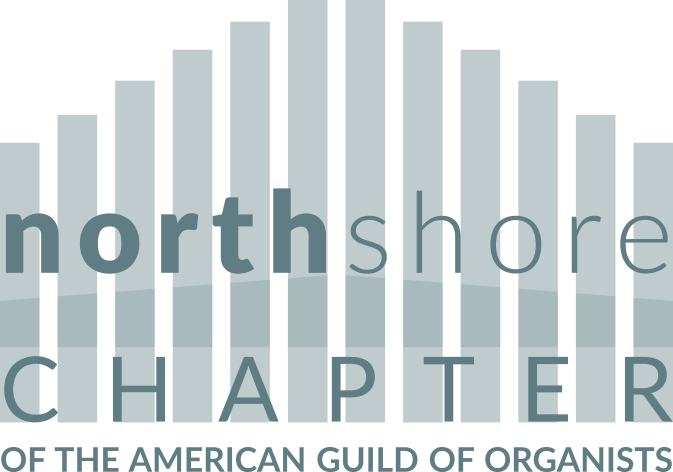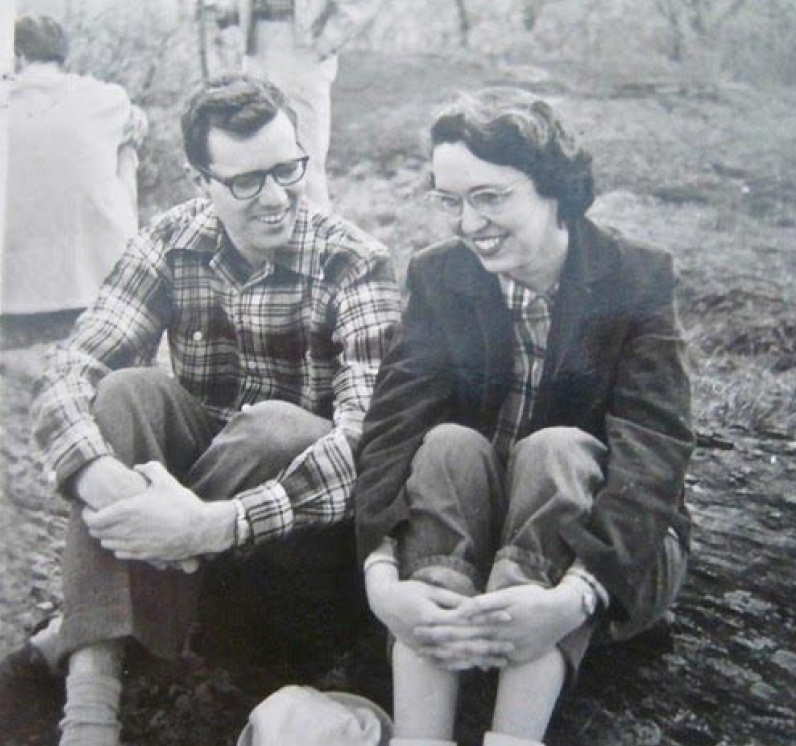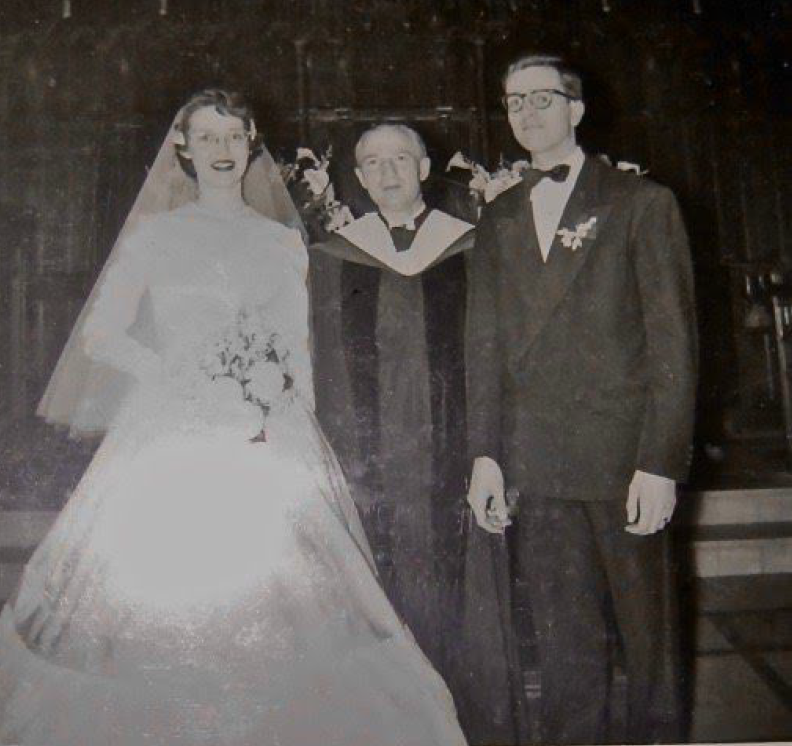By Morgan Simmons
Former Organist and Choirmaster at Fourth Presbyterian Church, Chicago
Morgan and Mary, his wife, served there together for 28 years
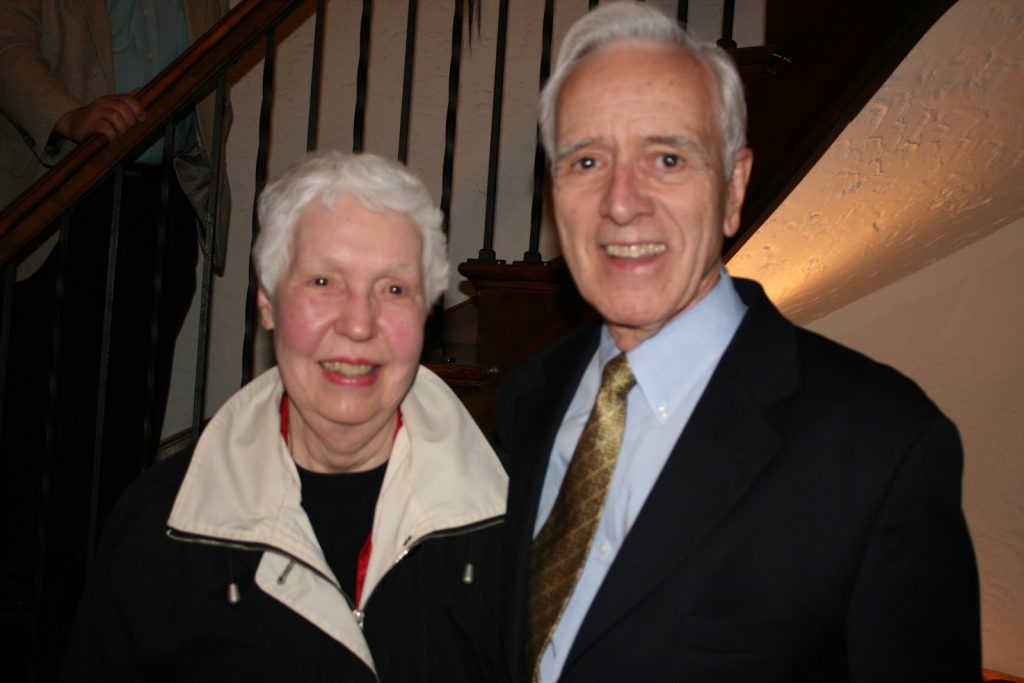
Last month, I asked Morgan Simmons if he would share some of his life’s story with us. Imagine sitting down for a fireside chat and having the opportunity to hear him recount the blessings of being in the right place at the right time. In his humility, he wanted to leave some of this out, but of course every word is part of the story. Never one to not follow through on a project when he is asked, here is Part 2 of the memoirs written just for us. We continue to see how Morgan’s full life interweaves his love of music, gardening and needlepoint – all of which serve to point us to the sacred.
On an early September morning of 1951, I opened my eyes groggily to the then-swampland south of Newark, New Jersey, wondering what lay ahead as we approached Penn Station in New York — remembering with trepidation other train rides: the first when I arrived at Greencastle for my freshman year at DePauw without my wallet, and the second when I left my briefcase (filled with the complete organ works of J. S. Bach) on the exit platform at this same Penn Station having just returned from Germany in 1949. The wallet had worked its way out of my unbuttoned hip pocket, travelled on to Chicago, and was returned with $40 and other items intact, and the briefcase was sent back to Greencastle undisturbed. Talk about serendipity! The adage “God takes care of fools and children” was in full force.
As instructed, I took the Seventh Avenue Express Subway to 96th Street and changed to a local for the ride to 116th where I walked to 122nd Street and Broadway to enter the hallowed halls of Union Theological Seminary. The dream of studying at Union was now a reality, unfolding at a time when its School of Music was in its heyday and the cultural offerings of the city were in full glory.
DePauw friend Charles Heaton, who was in his second year of the SMM degree program, and with whom I would share a three-room dorm suite, welcomed me. Charles eased me into the routine of seminary and city life and soon I was in full throttle — classes five days a week, organ lessons with Hugh Porter (Director of the School), an organist/choir director job at St. Luke’s Lutheran Church in New Rochelle, and weekend afternoons spent attending oratorios at leading churches or free concerts at The Frick Collection of Art or Carnegie Hall.
Clarence Dickinson was still at Brick Presbyterian Church; Harold Friedell at St. Bartholomew’s; Charles Courboin at St. Patrick’s; T. Frederick H. Candlyn at St. Thomas’; and Robert Baker at First Presbyterian in Brooklyn. There was no admission charged at the churches, and tickets for The Frick and Carnegie Hall were free for the asking. At the former I heard Wanda Landowska twice and Toscanini six times with the NBC Symphony at the latter. Also at Carnegie Hall, I had the great pleasure of hearing Kirsten Flagstad’s farewell conceaccompanied on the piano by Bruno Walter. After fifteen minutes of thunderous applause following the concluding number, the stage manager came out and announced that Madame Flagstad was at her hotel!
Among the highlights of musical life at UTS was singing a concert at Carnegie Hall under the direction of Robert Shaw with Hugh Porter at the dated Kilgen organ performing Janacek’s “Glagolitic Mass” and Hindemith’s “When Lilacs Last at the Dooryard Bloomed.” But the BIG highlight that outshines all others: the reality that I was falling in love with fellow student Mary Day, which hit me like a ton of bricks at a retreat at the Porters’ cottage in Connecticut. That love deepened over the summer of 1952 and was sealed on May 17, 1953, when we were married in James Chapel of Union Seminary, with a reception following on the 15th floor of Riverside Church. Graduation followed two days later at that same church, where George Buttrick, who gave the commencement address, would figure prominently in our paths forward.
In addition to manning a switchboard on Friday nights at Hastings Hall and washing practice organ keys to supplement my modest scholarship, I also made sandwiches in the cafeteria of the undercroft of Riverside Church. Among the clientele were the church organist, flamboyant Virgil Fox, and none other than his eminence Harry Emerson Fosdick (the man who persuaded John D. Rockefeller to erect the massive church).
Knowing that I would likely be drafted into the Army, Mary and I accepted jobs at the first Church Music Conference at Montreat, North Carolina, where I would conduct the choir and she would accompany. Fate fell before the three-month term was over, and I returned to Alabama for induction. Eight hellish weeks of basic training at Fort Jackson, South Carolina, ended on a positive note — serendipity again in force. DePauw friend Fred Kent, who worked in the Third Army Chaplain’s office, asked me where I would like to be stationed after the nightmare. I told him that Fort Benning, Georgia, was my first choice because it was near home, and my sister and brother-in-law were stationed there.
I had a posh situation — serving as a chaplain’s assistant in a remote area of the base, where I was essentially my own boss. This allowed me practice time on the chapel’s Hammond Organ and for a correspondence course in French, which I would need for my doctorate. Mary had a secretarial job and served as an organist accompanist at a church in Columbus, Georgia, where both of us were instrumental in forming a Chapter for the American Guild of Organists. By night I began my first real needlepoint project — the back and seat for a rickety antique side chair. We carefully pulled the drapes in our modest apartment to shield the neighbors from seeing this oddball stitching away. On the auspicious date of 5/5/55, our son David was born at the base hospital very shortly before my separation from the Army. The dream of starting a family was a reality.
Anticipating beginning doctoral studies at Union Seminary, I “hitched” a ride on an Air Force plane piloted by a major general who needed flight–time for his resumé. We landed at the Brooklyn Army Base, and I took the subway into Manhattan for an interview with Hugh Porter. While navigating my way through the ground floor of the Seminary, I opened a corridor door and came face to face with Eleanor Roosevelt, who was on her way to a speaking engagement. More serendipity
Distilling what followed is a daunting task. After summer school at UTS, Mary, four-month-old David, and I set sail for England, where I would study at the Royal School of Church Music, housed at Addington Palace (former home for the Archbishop of Canterbury), courtesy of a Fulbright Scholarship. There I came under the tutelage Cyril V. Taylor. Among the bigger-than-life experiences for both Mary and me was shaking hands with Prince Phillip at a reception for Fulbright Scholars. I had a few organ lessons with Sir William Harris, organist to the Queen at Windsor Castle, and spent many profitable hours at the Library of the British Museum researching material for my doctoral dissertation: Latin Hymnody: Its Resurgence in English Usage.
Apart from absorbing British culture, we had an amazing five-week tour of the continent in a VW “Bug,” which belonged to my boyhood friend Dr. Joseph Merrill, who accompanied us for part of the tour, as did our new-made friend Shelagh. Among the highlights: spending Easter in Paris hearing all the “greats” at their posts: Dupré at St. Sulpice, Langlais at Ste. Clotilde, the Duruflés at St. Etienne-du-Mont, André Marchal at Saint-Eustache, and Pierre Chochereau at Notre-Dame; fingering the oldest organ in playing condition in Sion, Switzerland (dating from 1380); visiting the ruins at Pompei; driving along the Amalfi Coast; enjoying a guided tour of the Vatican Museum; taking a return trip to Salzburg; and hearing a number of historic organs in Germany and the Netherlands, where it was tulip time at Keukenhof Gardens.
Back in the States, I began a happy six-year stint in New Jersey at Bound Brook Presbyterian Church, where I was Organist and Choirmaster with Mary serving as Assistant Organist, while I commuted to New York for doctoral studies at Union. This historic church, founded in 1688, provided a magnificent laboratory for what I was learning in the city. I formed a graded choir program of six units and discovered the delight of learning from young and inquiring minds of children.
In the youngest choir of first and second graders, I was teaching note reading and gave the traditional formula for the lines of the staff:
E-G-B-D-F — “Every good boy does fine (or deserves fudge)”— and asked the children to construct their own sentence and bring it to the next rehearsal. As expected, only two remembered. Becky raised her hand and read: “Early gardens bring daffodil flowers,” which I thought was quite charming. Then I called on Chucky, the Pastor’s son, and his response still delights me after all these years: “Every girl breaks down finally”!!!
But the most fortuitous occasions of those years were the expansion of our family. Son Robert was born on January 17, 1959, and daughter Kathryn joined us in late 1961.
A call from the placement office at Union in the summer of 1962 (a year after earning my doctorate) informed me of a job opening in Evanston, Illinois — a joint-appointment as Minister of Music at First Methodist Church and Assistant Professor of Church Music at Garrett Seminary.
(Both venues would change names at a later date.) The committee was slow in making a decision, and it was not until January 1 of 1963 that we began a five-year tenure at the church and a fourteen-year relationship at the Seminary; both positions were challenging and rewarding. I was plunged into teaching at the graduate level and into taking up the reins of a music ministry that had garnered national prominence under the leadership of Austin Lovelace. Building on that legacy, we inaugurated an annual festival of the arts, incorporating joint programs with Northwestern and the wealth of resources in the Chicago area, including the literature giant Nelson Algren, whom I interviewed in his northside apartment in Chicago. Mary and I were active in the North Shore Chapter of AGO and both served terms as Dean.
Early on, my love of all things floral was piqued by the wife of a Garrett faculty member, who grew gorgeous African violets under lights in their basement. She offered me cuttings, which I rooted, and I was hooked. For the next 40 years I grew violets, specializing in original species, and participated in national shows around the country, stacking up a bundle of ribbons, including “best in show” for specific categories.
I also had an adjunct position with the Music School of Northwestern University and soon learned that the music students were far better scholars than those at the Seminary — an affirmation made some years earlier by Henry P. Van Dusen, President of Union Seminary. It was echoed by his successor John Bennett, who bemoaned the closing of the School of Sacred Music, saying that the heart and soul of the community were greatly diminished
Compatibility with the head of staff of the church deteriorated, and my contract was not renewed because he saw me as “a dark spirit” whose presence made him uncomfortable. In this unfortunate state of affairs, we took solace in caring support of members and friends.
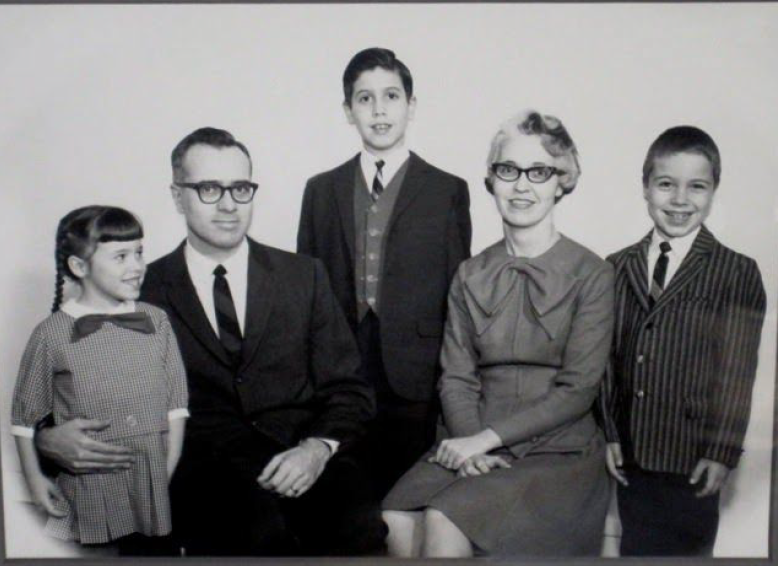
The family in 1967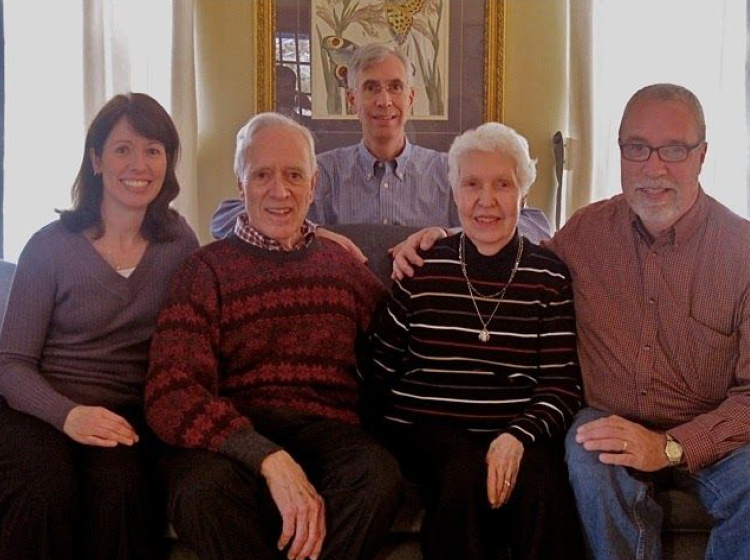
Still bonded in 2012
Essentially, I was out of a church position, but a Sunday evening call from Elam Davies, Pastor of Fourth Presbyterian Church of Chicago, soon changed that. After an interview and several telephone exchanges, Dr. Davies offered me the position that Wednesday. And as the saying goes, “the rest is history.” I would later learn that George Buttrick, who was serving on the faculty at Garrett, had recommended me to Dr. Davies. Thus from September 1968 until March of 1996 I had the great privilege of serving as Organist and Choirmaster with Mary as Associate Organist at what Elam Davies qualified with this dictum: “There are many good churches, but there’s only ONE Fourth Church”!
We bonded with Elam and his wife, Grace, and subsequently with his successor and wife, John and Sue Buchanan, counting ourselves as most fortunate among church musicians. Working in an environment of mutual respect and common purpose eased the pressures of juggling priorities but didn’t totally erase the demons of “shoulds” and “oughts” that have plagued me all my adult life. For coping, I’ve sought the balance of patience and impatience pursuing Dalcroze Eurhythmics, yoga, acupuncture, meditation, massage therapy, pastoral and personal counseling, Alexander Technique, vigorous aerobic exercise, and swimming at health clubs. The challenges continue to this day!
Beyond building a music program worthy of the reputation of Fourth Church, I served in a public relations capacity, preparing weekly newspaper copy for the local press, proofing Sunday bulletins, and physically delivering material to the printing office located in Evanston, enlarging bulletin type on Saturdays for the visually challenged. Eventually I became the editor of Fourth Focus, a monthly publication that featured church programs and personalities. During all those years, I never had a secretary but did my own typing. Elam was a real taskmaster and required executive staff to be on board six days a week. As exhilarating as this new role was, it took a toll on the quality time that I could spend with my children, and for that I have lasting regret.
Directing an all-paid choir was a new experience. Although I soon realized that professionals and volunteers have the same foibles, there were times that I needed to rein in the egos of divas, and for the sake of ensemble, I relied on the adage: “everyone’s a soloist; no one’s a soloist”! Achieving the blend embedded in my ear took time. Speaking of ear, I need to confess that quality of sound is more acute than individual pitch, and for pitch and intonation, I have depended on Mary’s incredible perfect-pitch ear for support. Sight and touch are my stronger senses.
Now for some peaks of those 28 years
- Of prime importance was replacement of the Skinner Organ, which was completed in 1971 by Aeolian/Skinner with consultation by Robert Baker. The 125-rank organ incorporated historic pipe work from the original organ of 1914 and was the impetus for concerts by world-class performers in both noonday and evening settings.
- In 1983 we inaugurated a Festival of the Arts, which over the years included painting, sculpture, literature, and music. Among the highlights were the Dave Brubeck Quartet, the Paul Winter Consort, and the capstones in 1987: Robert Shaw and Maya Angelou. Shaw preached at the morning worship service and that evening conducted the Morning Choir in Schubert’s Mass in G Major. On the way to O’Hare the next morning, he quipped: “That was the best goddamn Sunday I’ve spent in years”!
- The first of three choir trips to Europe began in July of 1988 — a tour of Germany and Austria, where we sang at the Dom in Salzburg as part of a church music festival, joining with another choir from the states of questionable ability, but sang alone my setting of “O vos omnes.” But the most moving event of the trip was visiting St. Florian Abbey, where Anton Bruckner is buried in the crypt, and singing his motet, “Virga Jesse,” in the chapel above.
- “Great Sounds, Great Spaces, Great Britain” was the theme of the second tour in August of 1990, which began in Edinburgh and included York Minster, Jesus College Cambridge, and Bath Abbey, to where my dear friend and hymnologist Cyril V. Taylor and his frail wife had taken the train from some miles away to attend.
- On our third tour, “Holy Roman Holiday,” in June of 1994, we sang in three venues: St. Paul’s Within the Walls, the Waldensian Seminary (both in Rome), and Santa Maria dei Ricci in Florence. Prior to the last concert, my briefcase full of music was stolen as we waited for check-in at our hotel. Fortunately there was a music store nearby where I was able to partially cover the loss. Food and sights were more scintillating than the music-making spaces! Villa Borghese Gardens at the top of the Spanish Steps fed my heart and soul.
Hymnic lore has long been central to my work as a church musician, and it was early in my academic life that I became associated with the Hymn Society in the United States (and Canada). Eventually I became
vice-president, and Fourth Church hosted the first national conference outside its then headquarters in Ohio. For the event, Holy Name Cathedral, St. James Episcopal Church, and the Newberry Library with its extensive hymnic collection were venues for lectures, services, and a festival. Following that gathering, the governing board was restructured and the post of vice-president eliminated. However, I later represented the Society in the Consultation on Ecumenical Hymnody, which met for several years and gave me the opportunity of association with scholars, both American and Canadian.
As I faced the challenges of organ playing, conducting, and administration, I sought to expand my skills with the best opportunities that were available: summer organ study with Arthur Poister at Syracuse University, choral workshops with Helmut Rilling at St. Olaf and Westminster Choir College, and various workshops around the country.
My association with Union Seminary deepened and widened through the years. For a number of years, I was active in alumni affairs and was elected as the alumni representative to the Board of Directors for one term in 1979 and subsequently elected as a full Board member for another four-year term, which entailed monthly trips to New York during the academic year.
Needlepointing had long been a welcome diversion and satisfied what one of my designers called my “itchy fingers.” That first armchair ended up being burned in a shop where I had taken it for repair, but it soon got replaced by covers for eight dining room chairs, a collapsible rocker that belonged to Mary’s great-grandmother, two side chairs, a wing chair, a hanging Persian rug, graduation pillows for grandchildren, and Christmas stockings for grandchildren and great-grandchildren.
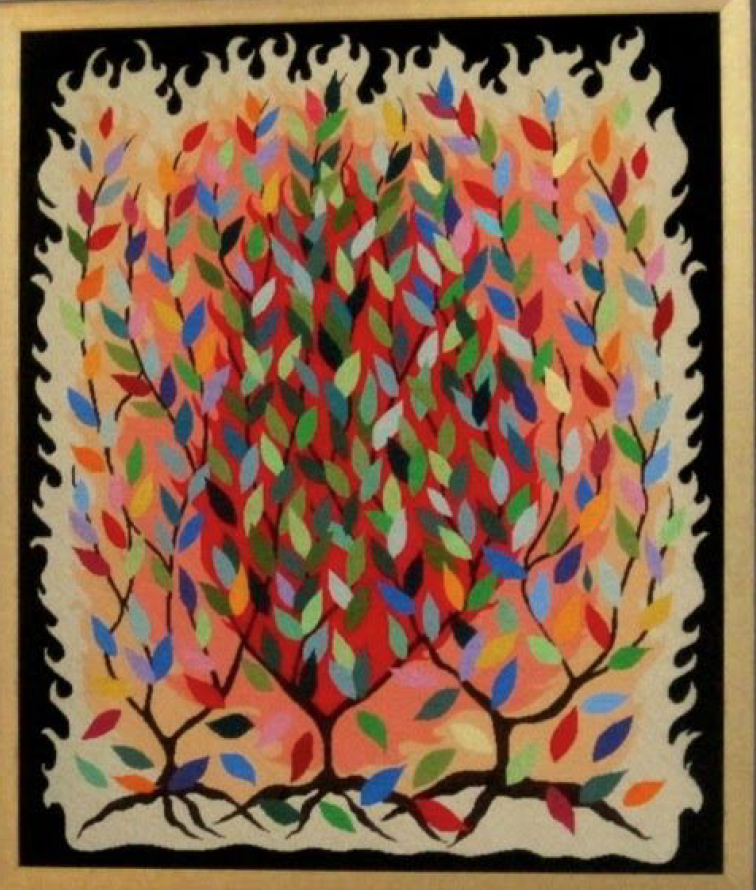
In anticipation for the refurbishing of the sanctuary of Fourth Church, I stitched seven cushions for seats in the lower chancel, gratefully being allowed to work on them during Tuesday morning staff meetings! After retirement I added many additional pieces, including “The Burning Bush” (pictured at left), which was created for the Gratz Center at Fourth Church.
Following retirement, I plunged further into gardening and became a member of the Evanston Garden Walk Committee, which selects gardens for the annual Garden Walk, and was soon chairman of the scouting group that uncovers hidden treasures around the city. This has been a rewarding enterprise that has introduced me to those who, like myself, are happiest when they’re digging in the dirt and communing with Mother Nature. I’ve been honored to be on the Walk for three different summers. In the early 1980s Mary and I expanded a narrow porch and added a greenhouse, which offered the opportunity of year-round gardening.

The love of travel also expanded in these retirement years, with more jaunts to Europe and beyond: Athens and Turkey, Amsterdam to Budapest, Moscow and Saint Petersburg, a Bach Anniversary tour to Germany, several cathedral and garden tours to Britain (Kew Gardens, Sissinghurst, and the Chelsea Flower Show), and a long-dreamed-of trip to Egypt.
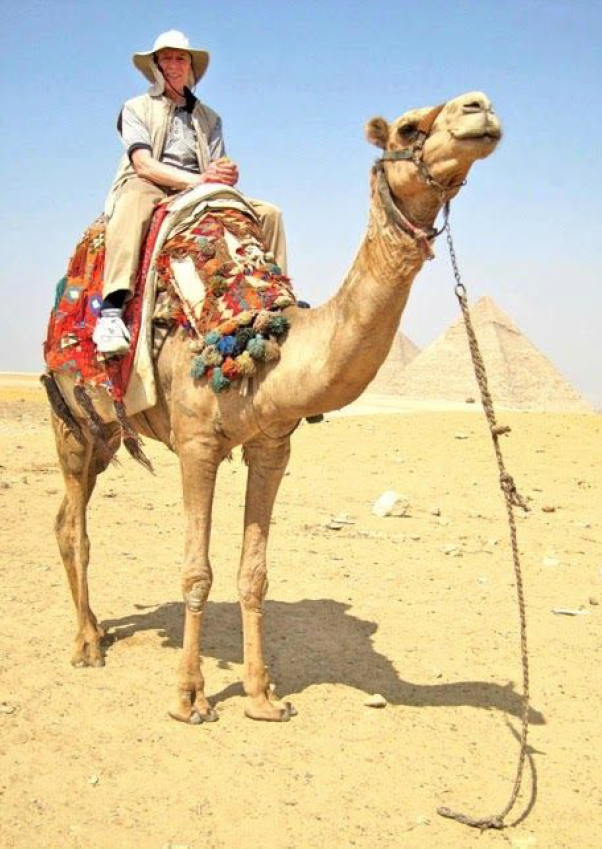
Our family of five has grown with the addition of seven precious grandchildren and four great-grandchildren, of whom we are justifiably proud as we watch them develop into productive individuals, each with special gifts and goals.
Serendipity bobs its head periodically, but was in amazing full display when Mary and I and the three children visited the Grand Canyon years ago. After admiring mouth-dropping views of God’s handiwork, we went to a nearby restaurant for dinner. Seated next to our table was none other than Ferde Grofé, world-acclaimed composer of the Grand Canyon Suite. When I ponder the ever-present question “Why me?”, I can only respond with deep gratitude for the incredible gifts that have come my way.
